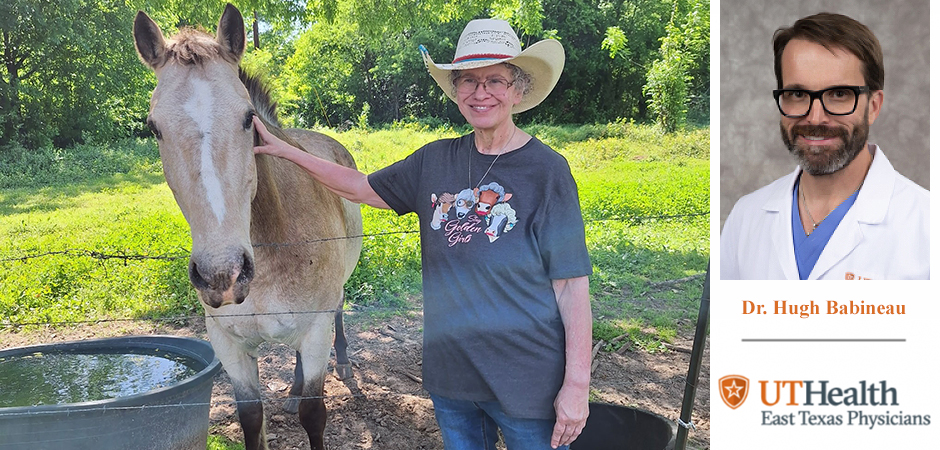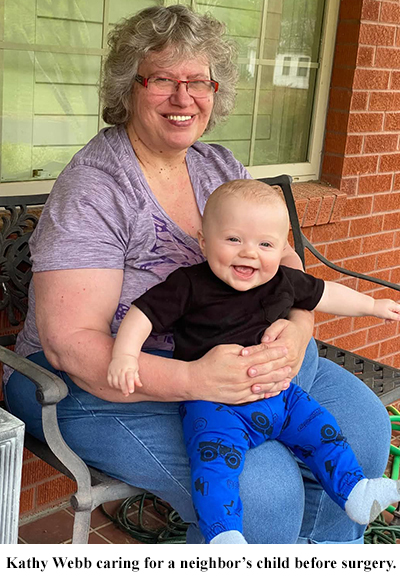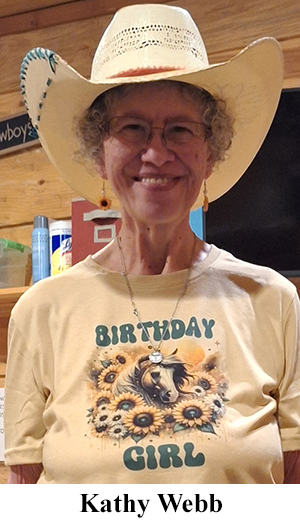
The woman carefully made her way down the narrow airplane aisle and settled into her seat. When she reached to buckle her seatbelt, she realized it didn’t quite fit. Feeling a bit unsure, she quietly raised her hand and gently asked the flight attendant, “I think I need an extension belt.”
The flight attendant smiled warmly and replied, “You don’t have to whisper, sweetie. We give those out to a lot of people.”
 Looking back on that moment, Kathy Webb from Henderson, Texas, shared, “Asking for the extension felt really embarrassing to me.”
Looking back on that moment, Kathy Webb from Henderson, Texas, shared, “Asking for the extension felt really embarrassing to me.”
At her heaviest, Kathy weighed 278 pounds and was managing several health challenges, including pre-diabetes, high cholesterol, an unstable thyroid, chronic obstructive pulmonary disease (COPD), and sleep apnea.
“My husband Troy would tell me that sometimes I’d stop breathing for brief moments while I was sleeping,” Kathy said softly.
She traces much of her weight gain to a difficult period nearly 20 years ago, when her mobility was limited.
“I had my left knee replaced in 2008 without any issues,” she recalled. “But after my right knee replacement a year later, I struggled with walking and exercising, and that’s when the weight started to add up.”
Bariatric surgery
Once she decided to do something about her health, Webb met with Hugh P. Babineau, MD, FACS, FASMBS, a bariatric surgeon at the Tyler Bariatric Center.
“Dr. Babineau is wonderful and so informative,” said Webb. “We sat down and talked about the different types of bariatric surgery. When I mentioned that I often had GERD (gastroesophageal reflux disease), he recommended gastric bypass surgery, which works well for someone with GERD.”
 The gastric bypass procedure divides the stomach into two unequal parts. The top part, now called "the pouch," is only about the size of an egg. The rest of the stomach is called "the bypassed stomach" because food and drinks no longer enter it. The bypassed stomach was not removed and continues to produce stomach enzymes.
The gastric bypass procedure divides the stomach into two unequal parts. The top part, now called "the pouch," is only about the size of an egg. The rest of the stomach is called "the bypassed stomach" because food and drinks no longer enter it. The bypassed stomach was not removed and continues to produce stomach enzymes.
Once the pouch has been created, food enters at the top, exits through the stoma and travels into the intestines where digestion occurs. The enzymes from the bypassed stomach travel down a different part of the intestines to mix with the food. No parts of the stomach or intestines are removed.
“Everything sounded great to me, so that’s the surgery I agreed to have,” said Webb.
While preparing for the surgery, Webb became serious about losing weight. “I wanted to prove to myself that I could stick with the diet I was going to be on for the rest of my life,” she said. “I also wanted to show Dr Babineau and everybody else that I would stay on the diet. I was determined to lose the weight and stay healthy for myself.”
When she was two weeks away from the surgery date, she went on a liquid diet and dropped her weight to 251. When Megan, Dr. Babineau’s assistant, noted that the surgery date was scheduled the day after her birthday, Webb replied, “Yes, this will be my birthday present to myself.”
There were no complications during Webb’s surgery. She returned home after spending one night in the hospital.
New activities and diet

True to her word, Webb continued to eat healthy foods and increased her activity. The first week after surgery, she ate liquid foods for a week, such as sugar-free gelatin, chicken and beef broths. During the second week, she started introducing soft foods like scrambled eggs into her diet.
“My stomach is the size of an egg,” she said. “I used to eat a whole plate of food and go back for more. Now I can't eat more than a piece of chicken and a small plate of vegetables.”
As for exercising, she will walk on a treadmill or pedal a stationary bike, but she prefers to be outdoors.
“I love walking,” she said. “Before my surgery, I was always walking, perhaps two to three miles every day. I had no problems until the trouble with my right knee. Now I’m walking everywhere, even at church. There’s a covered arena on the church grounds, so I am often walking there.”
When the 60-year-old retiree is not at home with her husband and caring for her horse Matt, she is often at the Bar None Cowboy Church in Tatum, Texas. “I work in the nursery there on Sunday mornings, Monday nights and Wednesday nights,” she said.
“Since my surgery, I now weigh 143 pounds. Everybody at church looks at me and says that if I keep losing weight, I will blow away. Troy tells our family that I am a different person, that I lost a ‘whole person’ since my surgery. They now call me ‘Miss Skinny.’”
Webb credits her good health to Dr. Babineau and his staff. “They were just great,” she said. “If I had any concerns, Dr. Babineau was always there to answer my questions. Megan and other staff members were always calling to check on me and answer any questions. I have told folks at church that if they are looking into weight loss surgery, they should call Dr. Babineau’s office. He is awesome.”
As for flying again, months after her surgery, Webb flew to Ohio for a women’s business conference. “No, I did not have to ask for an extension,” she recalled. “The regular seat belt worked perfectly.”
For more information about bariatric surgery, visit www.TylerBariatrics.com.

